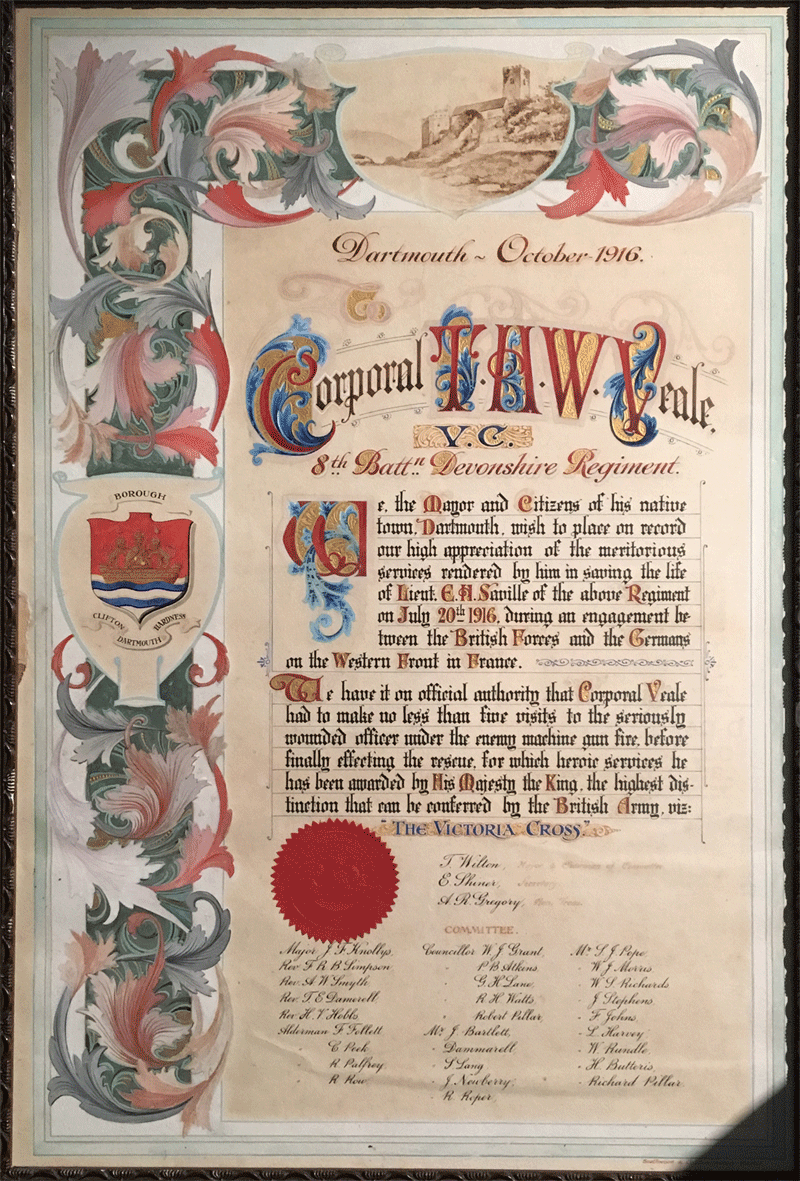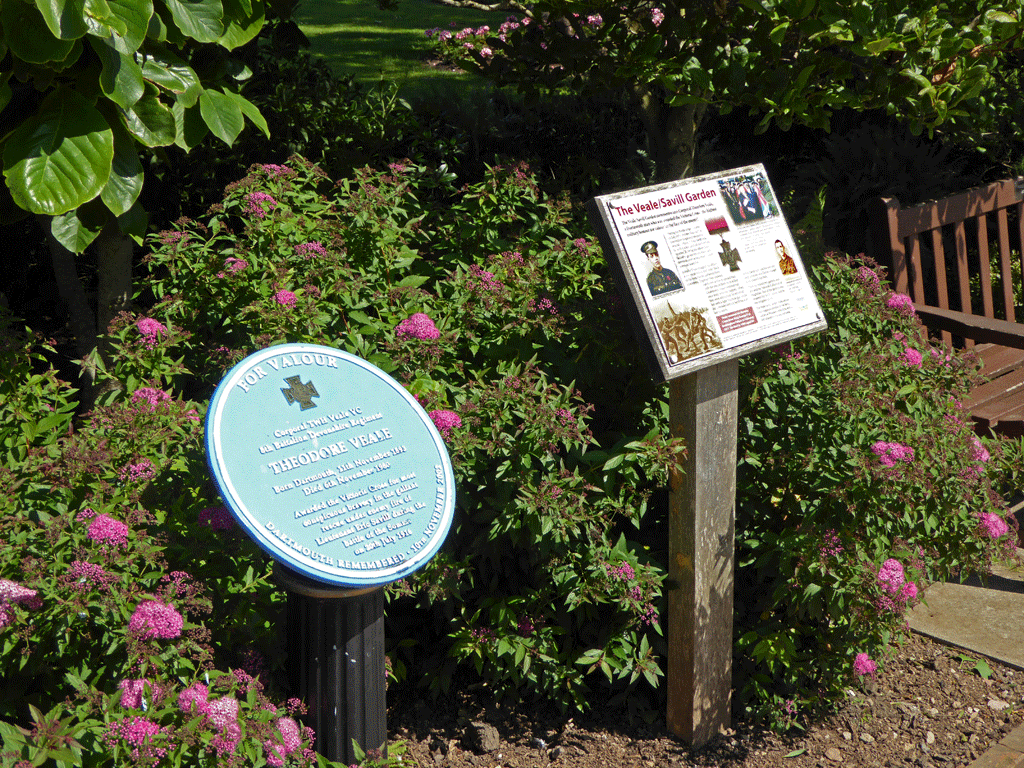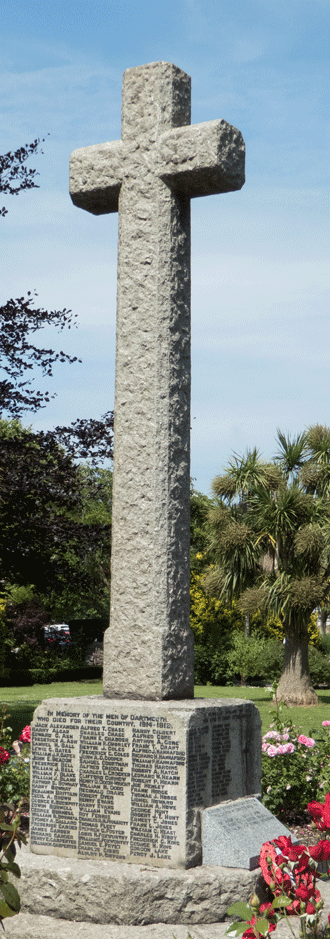The 8th Devons at High Wood
20th July 1916: High Wood, and Theodore Veale
The attack at High Wood was the third major attack undertaken by the 8th Devons in three weeks.
Early in the morning of 14th July 1916, the 8th Devons had successfully taken Bazentin le Grand Wood, between the villages of Bazentin le Grand and Bazentin le Petit, lying just behind part of the German second line of defence on the Somme front. By 5.45am, according to the 7th Divisional History, the prospect before them was inviting:
The country ahead was a refreshing sight, green pastureland unscarred by shell-holes and broken by an occasional hedge, while High Wood itself was in full leaf, not a tree as yet damaged by shell-fire.
Officers from the Devons and Brigade Headquarters walked up the slope towards High Wood, and there seemed to be an obvious opportunity to take the advance further forward. But 7th Division was told to wait for the cavalry. After a considerable delay, due to difficulties in getting over the ground, High Wood was attacked by 91st Brigade on the left, and famously, the Secunderabad Cavalry Brigade on the right. By this time, German defences had been reorganized.
Although the attack did secure a position in the wood, it was too far in advance of the rest of the line, and too much of a salient, to be tenable. Mounted action could not take place in the dark, and the cavalry were withdrawn in the evening, and the 91st Brigade was withdrawn two days later. Whether High Wood could have been taken had the attack been pressed forward immediately, with the forces available at that moment, is a matter of opinion. Many later commentators have argued that this was the most significant opportunity for a breakthrough - and at the time, German commanders evidently recognised that there was a significant risk, since four divisions were brought in overnight to the Longueval-High Wood area.
Over the next few days, fighting was heavy. Recognising the threat of the British offensive, offensive action was called off at Verdun, and key commanders and troops diverted to the Somme. German reserves were brought up, and the defending forces resisted every British attempt to push forward, taking every opportunity to strengthen and deepen their third-line position, called "Switch Line" at this point, a portion of which ran through the northern corner of High Wood. It became clear to the British High Command that High Wood and other positions ahead of the German third line required a general attack, properly prepared.
On the 19th July, the 8th Devons were thus brought back to the front after only a few days rest, to take part in a further attack on High Wood. Thirty-Third Division attacked the wood itself, whilst 7th Division's objective lay just to the south-east of the wood. The 8th Devons were on the right of the divisional front, with the 2nd Gordons, supplemented by a company of 9th Devons, on the left, immediately south of the wood.
The 8th Devons' objective was the ground over which the Secunderabad Cavalry had attacked. It consisted of two roads, running south east of the wood towards the village of Longueval, parallel to each other, and about 300 yards apart. The first road was called Black Road and the second, Wood Lane. They ran along the top of a ridge covered with standing corn. Since the cavalry's advance, there were also many dead horses. A little further to the north-east, and extending into and through the wood, was the German third line position, at Switch Line. From the 8th Devons' position at Bazentin le Petit, the ground sloped upwards to the first road.
The plan involved a nighttime attack, in a repeat of the successful approach to Bazentin le Petit. Zero hour was 3.35am, and the Devons began crawling forward about twenty minutes earlier. The leading lines were close to Black Road when the short, hurricane barrage opened, and following the barrage, they were able to occupy the road without difficulty.
As they moved towards Wood Lane, however, German defenders were now fully alert to the threat. The Devons came under heavy fire from riflemen and machine gun positions hidden by the standing corn, and also from machine gun positions in Switch Trench. During the advance, they also came under fire from the British barrage, intended for the second road, but falling short. According to Major Dawes' report after the action, "Green flares were used freely, but our guns did not lift and continued to fire short". Furthermore, German artillery positions proved to be on a reverse slope almost totally out of view of the British lines; and British artillery observers could not get a good view.
In such circumstances, it is hardly surprising that casualties were very heavy, including both company commanders - one killed, the other, Lt Savill, badly wounded - and two of the four platoon commanders in the first wave were also killed. The enemy were effectively concealed and anyone raising themselves sufficiently to observe their positions was hit at once.
The attack thus stopped 25 yards from Wood Lane. The 2nd Gordons had also captured their section of Black Road, but had suffered heavily whilst trying to reach Wood Lane. High Wood had not been taken - although 33rd Division had gained some ground, German machine guns at the edge of the wood had not been cleared.
By 7.00am, all the 7th Division assault companies, including the 8th Devons, had withdrawn to Black Road, where the support company had been able to consolidate the position gained earlier, with reinforcements from the fourth company. The withdrawal was covered by two Lewis gun teams, one on the left headed by Sergeant Potter, and the other on the right by Lance Corporal Forrester. They remained forward out in the open, while the remainder of A and C Companies withdrew. Furthermore, they prevented German forces following up the retreat.
Sergeant Potter's gun was attacked several times, but all were fought off; an invitation to surrender was also refused, with force. Eventually he went back to ask for instructions, but was wounded. The gun team, with the gun, was then ordered back to the first road. Lance Corporal Forrester's team remained out on the right until the evening. Although one man was killed and three others wounded, their position was effective, and Lance Corporal Forrester was determined to make the most of it. After dark, he brought back the team, including the wounded, with the gun; and picked up another wounded man on the way.
Both Sergeant Potter and Lance Corporal Forrester were cited for the VC by Major Dawes, the 8th Devons Commanding Officer, following their "splendid and resourceful gallantry". In the event, Sergeant Potter received the DCM, while Lance Corporal Forrester received the MM. The VC went elsewhere.
Theodore Veale
In the meantime Theodore Veale, who had gone up to the front to help the stretcher-bearers, had rescued the badly wounded Lt Savill. There is no mention of this in the Battalion's War Diary but the following account comes from a letter he wrote to his mother. An edited version of the letter (with grammar and phraseology tidied up) appeared in the Dartmouth Chronicle of August 18th, 1916 - here we reproduce the original. It gives a clear picture of the conditions in which the action took place.
Well I done a bit of rescuing work while under heavy shell & rifle fire, while we were up last time. It appears we were in trenches and Corpl of Co[mpany] said that someone in front was waving his hand to come in, he said it was a German wanting to give himself up, anyhow we waited and he didn't come so later about 20 minutes I heard someone cry help, help & I said give me a rifle & bomb & out I went, I had not gone about 50 yards which was all in the open when several shots rushed by me, I flopped down on the ground, & got up again and ran on, until I found spot I had seen man waving & to my surprise it was one of our own wounded officers, so I laid down & done all I could to him, & I was fired at while there. He being so close to Germans I pulled him back about 15 yds, because to my surprise I was about 10 yds from Germans, & thinking that they were going to pull him in I done that. Well I came back to get water took it out to [him] & [they] fired at me again Surprising how I was not hit. But I meant to save him at all costs. So off I crawled back again because it was all open & I got two more men and a corpl to come out with a waterproof sheet I put him on & started to pull him back & got about 20 yds, & had a rest & you know how ones back aches after stooping, well the corpl stood up on his knees & I saw five Germans pop up out of the grass about 100 yds away then, because my getting him back so far and the distance we got him back together made it easier for them because we had to come over a bit of [trench] bridge & they shot corpl right through the head and that made the other 2 nervous & they wanted to get back, so I said Go back & I'll manage, so they went & I pulled him in a hole & asked him if would stay until a little dusk so left him comfortable & went back, then I sent my team & myself out on left of him to fire & cover any of them [the Germans] that may try & fire at him. And I tracked out to him with water in the afternoon. These enemy came and I led the way for our chaplain who was also acting stretcher bearer, Lieu Duff, Sergt Smith and myself I took them out and reached him, & was about to carry him in, mind it was not dark, & we spotted Germans creeping up. Mr Duff turned around & kept his eye on them with revolver & I not thinking stood up & run like hell about 150 yds to trench for my gun, I raced out again & covered him & others while they raced in then me and Mr Duff had to get in which we did safely & after going in and out all day I was never touched. Don't you think I am lucky & did well. So will begin to pack up now, I have about said all. The weather is fine have more to say next time. This is a quick few lines in a hurry.
The chaplain referred to was the indefatigable Ernest Crosse (see the story of Robert Phillips Willing), leading a team of three stretcher bearers, and waiting in the rear. Describing the overall situation, he later wrote:
We knew nothing of the situation and the fighting was pretty heavy, then I met an 8/Devon runner who told me. Whereupon I set out with my squad in open order. I reached the nearer road where I found only one officer. He was quite dazed and could hardly answer my questions as to whether there were any wounded, and if so, where they were. At first he said there was no-one left. Eventually I found one wounded Devon on the road. I gathered that he had tried to advance to the second road and found it too strongly defended. Another Devon crawled through the corn as I was there. I still had one empty stretcher, so I went to the Gordons and took down a wounded Jock.
Theodore Veale's citation appeared in the London Gazette of 9th September. It read:
For most conspicuous bravery. Hearing that a wounded officer was lying out in front, Private Veale went out in search, and found him lying amidst growing corn within 50 yards of the enemy. He dragged the officer to a shell hole, returned for water and took it out. Finding that he could not single-handed carry in the officer, he returned for assistance, and took out two volunteers. One of the party was killed when carrying the officer, and heavy fire necessitated leaving the officer in the shell hole.
At dusk Private Veale went out again with volunteers to bring in the officer. Whilst doing this an enemy patrol was observed approaching.
Private Veale at once went back and procured a Lewis gun, and with the fire of the gun he covered the party, and the officer was finally carried to safety.
The courage and determination displayed was of the highest order.
He received the award ahead of the other nominees because his conduct, example and leadership was consistently above that expected from a soldier of his age, rank, and experience. He was promoted to Corporal immediately afterward.
The 8th Devons were relieved at 10.30pm on the evening of the attack, having incurred casualties of seven officers and 153 men, principally among A and C companies who had led the attack. The remainder had a ten mile night march to billets in the rear area; but remained out of the fighting for several weeks while the Battalion was rebuilt.
The announcement of Theodore Veale's VC caused much excitement in Dartmouth - it was a rare piece of good news. Since he had joined up, he had been a regular correspondent, writing to Alderman Peek to let him know how the Dartmouth men were doing (see the story of Andrew Prettyjohn, the first of the Dartmouth men who joined the 8th Devons to be killed in action). The Town Council (and other authorities) organised an elaborate public reception in the town; and Theodore Veale was presented with an Illuminated Address and an inscribed silver coffee pot and salver. He was then taken by carriage to his family home in Dartmouth, by that time, 12 Mansard Terrace.

He received the award from King George V on 5th February 1917. Both he, and the man he saved, Eric Savill, survived the war. Eric Savill was the son of a chartered surveyor, Sir Edwin Savill, and after the war became a surveyor also, becoming a partner in his father's firm. From 1930, he managed the Windsor Crown Estate, including Windsor Great Park, where he created the Savill Garden. He was knighted in 1955.
Much later in life, Theodore Veale was forced by financial need to sell his VC and other war medals. They were bought by the Devonshire and Dorset Regimental Museum, and are now on display in Dorchester.

In 2016, on the centenary of the attack on High Wood, and the day Theodore Veale saved Eric Savill's life, a commemorative paving stone was laid in Dartmouth, one of 469 to be laid across the country in the birthplaces of those awarded VCs during the Great War.
Biographical details
Theodore Veale does not appear on our database because he survived the war. A short biography follows.
Theodore Williams Henry Veale was born in Dartmouth on 11th November 1892 and baptized at St Saviours on 9th February 1893. He was the son of Henry Peek Veale and his wife Ada King Williams.
Henry Peek Veale's forebears had lived in Dartmouth for several generations - he was a builder and mason, as his father and grandfather had been. In 1890 he married Ada King Williams at Charles the Martyr, Plymouth; according to Census information, Ada was born in London, in Rotherhithe. Theodore (or Teddy) was the elder of two sons - his brother Lawrence John Veale was born in 1894. In the 1901 Census, the family were recorded living in Lower St; by 1911, they had moved to 3 St Clairs Terrace. Shortly after the Census was taken, a sister was born, Thora Florence Ada. Theodore was working as a mason and his brother, Lawrence, as a carpenter.
Living with the Veales in 1911 were two sisters, Elsie Walmsley and Alice Walmsley, aged 12 and 10, the daughters of John Henry Walmsley, killed at the Battle of Jutland. See his story here.
According to a newspaper article published at the time of his award, Theodore Veale "is well known in Dartmouth, for he is one of the best all round athletes in the town ... at swimming, jumping and running he was continually to the fore". He was a member of the Dartmouth United Football Association, and also the Dartmouth Athletic Reserves.
Theodore Veale was discharged from the Army in 1919 and the following year married Amy Rose Pinsent at St Saviour's Dartmouth, on 13th April 1920.
He died on 6th November 1980 at his daughter's home in Hoddesdon, Hertfordshire. He was one of the oldest surviving VC holders.
Sources
War Diary of 8th Battalion Devonshire Regiment, July 1915 - November 1917, available from The National Archives, fee payable for download, reference WO 95/1655/2
The Devonshire Regiment 1914-1918, compiled by C T Atkinson, publ 1926, Exeter and London
West Country Regiments on the Somme, by Tim Saunders, publ 2004, Pen & Sword Books















